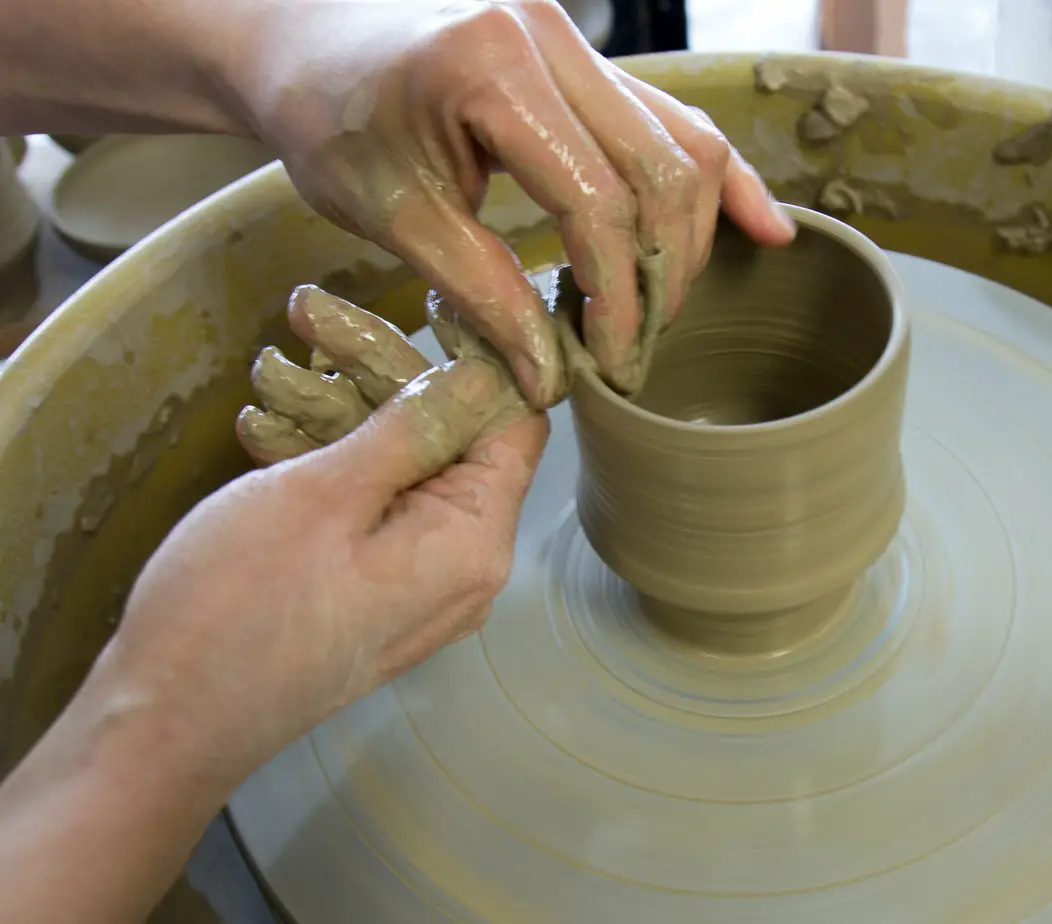In your pottery-making experience, when you’re working at the wheel, you’re probably pretty happy with the results, but did you know that you could elevate your craft to a whole new level? There are a few ways to improve your pottery at the wheel markedly, but there is one thing that stands out from the rest, and in this article, we’ll reveal what that is.
Understanding the number one thing to improve your pottery at the wheel will change how you approach the process and the results you get while helping solve specific common problems you may be facing.
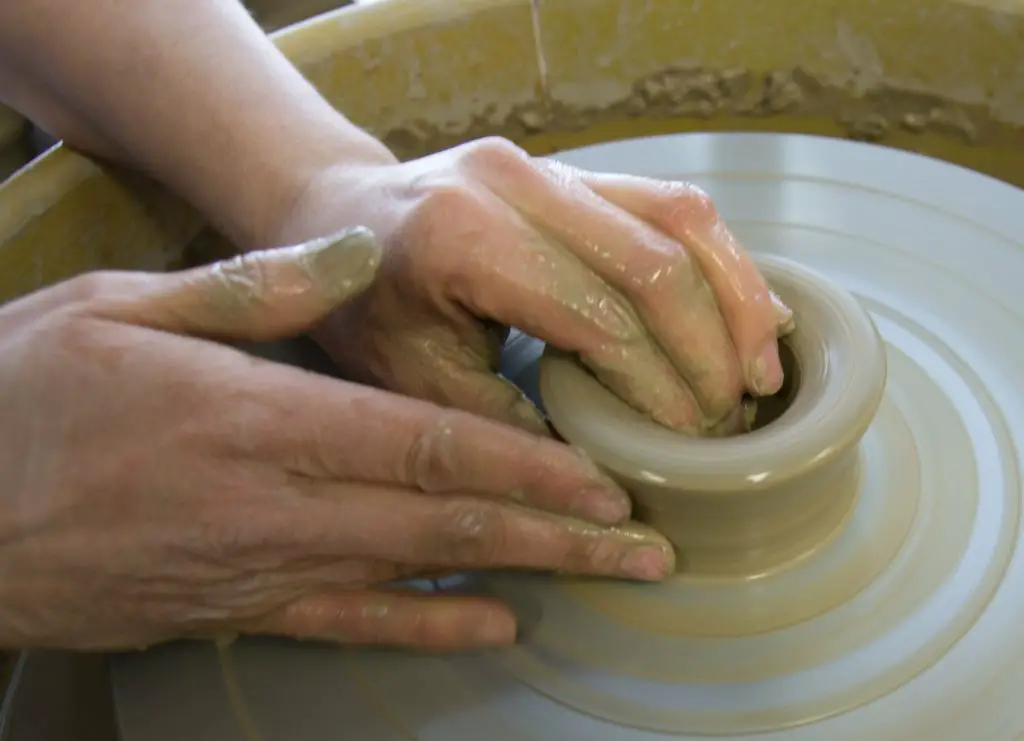
So what is it?
Now, without delay, let’s explore a crucial aspect that can significantly influence your pottery endeavors: gaining insights into the specific characteristics of the clay you are working with and determining the precise quantity of water essential for the clay. What makes this knowledge indispensable? The answer is that to create any pottery piece adeptly, a potter must possess a solid understanding of these foundational principles.
Here are a few reasons why you must become familiar with both the clay and the water you use:
- It can aid you in forming any pieces you may wish to make
- It can help eliminate problems emerging from the lack of water usage
- The type of clay plays a significant role in your ability to throw
- It can also help you better optimize the way you make pottery, thereby reducing risks of strain or injury
But how does knowing this change your pottery immediately? Well, let’s talk about the different factors that go into each of these, and why they’re so important.
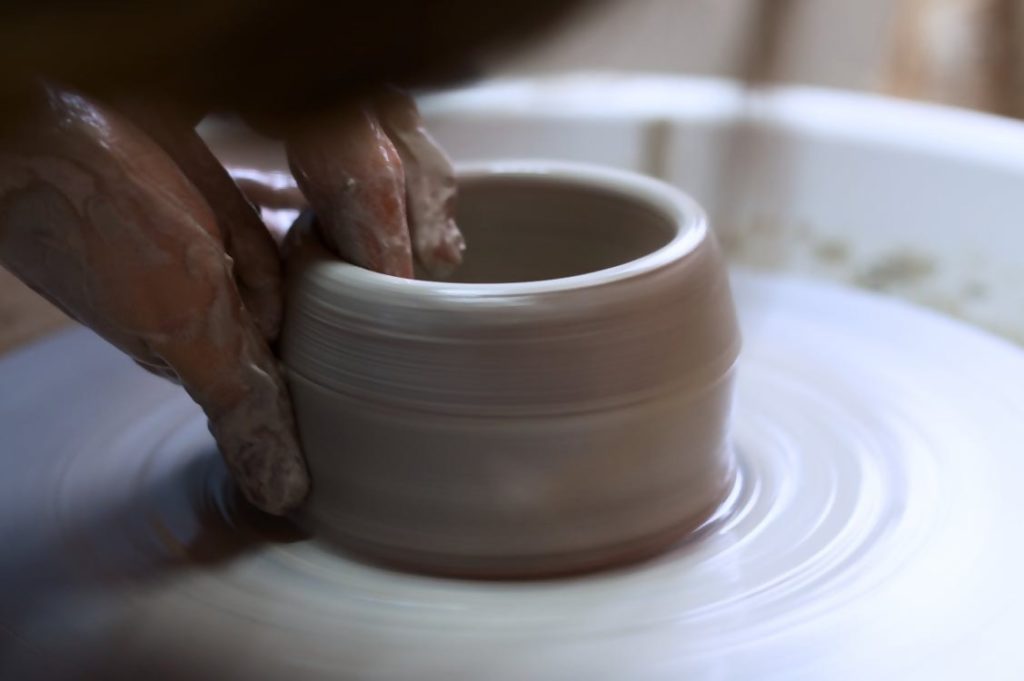
Understanding the Significance of Water in Pottery Making
A pivotal element in the art of pottery involves appreciating the importance of water content. To improve your pottery’s maneuverability and visual appeal, it is essential to comprehend the interplay between clay and the necessary water. Presented below are vital insights and rationales underscoring the significance of your water utilization:
Water on the wheel is a fundamental element for minimizing friction.
- The presence of water is indispensable for executing pulls in your pottery.
- Achieving sleek and towering walls necessitates a discerning application of water.
However, excess water leads to clay absorption, potentially damaging the piece.
Have you ever encountered a pottery session where the addition of water resulted in a disorganized outcome? It is the consequence of an immoderate use of water. Striking the right balance is crucial—employing water for shaping without saturating your pottery.
Refined Approaches for Water Application:
The following are some refined approaches for applying water to your pottery:
- Limit water usage by employing the smallest amount possible.
- Opt for a modest amount of water instead of a fully saturated sponge, adding gradually.
- Hold the sponge with your outer hand to direct water precisely where needed.
- Exercise caution with sponge pressure to prevent excessive force and potential water seepage.
- When using a sponge on the pottery wheel, identify the optimal point that ensures adequate water for shaping without inducing chaos.
The Imperative Role of Water:
Indeed, water is indispensable. Dispel the notion that minimal water is synonymous with a complete absence of it. Ensuring water is present on both your sponge and the pottery piece contributes to:
- Smoother walls.
- A diminished likelihood of sticking.
- Facilitation of a more straightforward pulling process.
Some novices mistakenly abstain from using water altogether due to the apprehension of excessive moisture. However, adopting such an approach jeopardizes the quality of your pottery. Aim for equilibrium by:
- Gradually introducing water.
- Utilizing more water when shaping walls.
- Embracing the sponge as a shaping tool without reservation.
- Investigating the properties of the water if manipulation of the pottery becomes challenging.
Remember, while excess can be harmful, a total absence of water is equally detrimental to your pottery. Strive for a harmonious balance in your water application.
The Impact of Water on the Texture and Finish of Pottery
Water has a significant role to play in the ultimate feel of the surface of any pottery item, from the texture to its finish. Here’s why and how it plays such an important role:
- Crafting Beauty with Water:
Water shapes a pottery piece’s texture and surface finish, influencing how the final piece looks and feels. It’s like the artist’s secret ingredient for creating something visually stunning and touchably unique.
- Water’s Lubricating Touch:
When water meets clay, it’s like a perfect dance—acting as a smooth operator by reducing friction between clay particles. This magical touch makes blending, coiling, and molding clay a breeze, resulting in a texture that’s not just cohesive but consistently smooth.
- Banishing Clumps with Water’s Help:
Picture water as a superhero swooping in to save the day. It breaks down those stubborn clay clumps, ensuring a uniform consistency. This superhero move is vital to achieving an overall smoothness that becomes the hallmark of the finished surface.
- Versatility Unleashed:
Water isn’t just a one-trick pony. Potters play with its power, applying and removing it strategically during forming. This creative dance allows for diverse textures—intricate patterns, subtle ridges, or intentionally uneven surfaces. It’s like painting with water for a masterpiece in clay.
- Guardian Against Cracks:
The magic of water doesn’t end in shaping; it extends to the drying process. Controlled drying, courtesy of water, refines the texture and acts as a guardian, warding off cracks and deformities. It ensures the artist’s vision is preserved in the final surface finish.
- Water Acts as the Potter’s Artistic Sidekick:
In the potter’s world, water isn’t just a tool; it’s a trusted sidekick in the quest for the perfect texture. It collaborates with the artist, allowing precise molding, shaping, and refining of clay—leaving an unforgettable mark on the finished pottery piece’s visual and tactile essence.
Managing Water Evaporation to Prevent Cracking
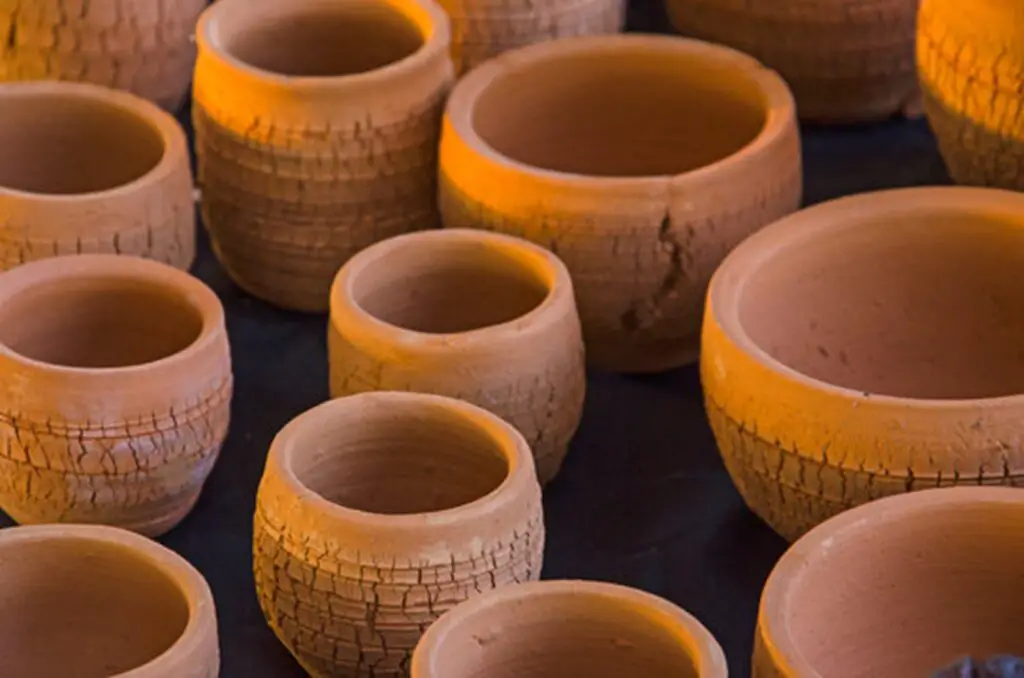
Managing water evaporation is a critical aspect of pottery craftsmanship, as it directly influences the structural integrity of the clay and plays a pivotal role in preventing undesirable cracks in the finished piece.
So, below, we have presented all the drying requirements you may come across while managing the evaporation of water in your pottery and the steps you can take to handle it.
| Drying Requirement | Steps to be Taken |
| Uniform Drying | Rotate the piece during drying to ensure even air exposure. Implement staged drying, allowing sections to dry gradually. Cover the work with plastic or damp cloths to slow evaporation. |
| Protection from Direct Air Exposure | Use plastic or damp cloths as a shield against direct air. Store work in a damp cabinet or wrap it in plastic during breaks. |
| Strategic Timing | Allow certain sections to dry before progressing to the next stage. Be mindful of ambient humidity levels to adjust the drying pace. |
| Preventing Localized Drying | Rotate the piece and ensure consistent air exposure on all sides. |
| Moisture Preservation during Breaks | Store work in a damp cabinet or wrap it in plastic during breaks. |
| Minimizing Stress-Induced Cracks | Control the rate of water loss to prevent internal stresses. Utilize a stepwise approach in drying to avoid uneven shrinkage. |
| Awareness of Ambient Humidity Levels | Adjust the drying pace based on the surrounding humidity levels. |
| Use of Protective Measures in Storage | Store work in a damp cabinet or wrap it in plastic during breaks. |
| Careful Handling of Dryness During Shape Forming | Avoid excessive drying manipulation that may create weak points. |
Clay Considerations
When engaging in pottery activities, you might recognize that the clay you use exerts a more substantial influence on manipulating pottery than initially perceived. It’s essential to consider the following points:
- The less clay you use, the shorter the structure
- Not every single clay is super stiff, nor is it super soft
- Some clay is better for beginners than others
With that in mind, you may see how this plays into how you do at the wheel. The right kind of clay can affect the following in your pieces:
- Your pulls, or lack thereof
- How high the piece ends up going
- How thin or how thick the clay piece is
That’s why, when you’re looking to improve your pottery, it isn’t just the water you’re working with but the clay. Below, we’ll go over how these clay-related factors play a role in your performance at the wheel.
Inadequate Use of Clay Material
Following a substantial investment of time into your project, preserving its stability emerges as a formidable challenge. A critical aspect deserving meticulous examination is the quantity of clay employed. For instance, more than merely utilizing a pound of clay is required when fashioning an exceptionally tall vase.
Consider these detailed guidelines:
- Proportional Requirement for Larger Creations: Crafting larger pieces necessitates a commensurately increased amount of clay to achieve optimal results.
- Exploration of Variable Approaches: Engage in experimentation with diverse methodologies to discern the most suitable quantity of clay for your specific project.
- Caution Against Excessive Clay: Conversely, an overabundance of clay can hinder the crafting process, leading to unwarranted delays in production.
Comprehending these foundational principles is imperative. Crafting a miniature pottery bowl, for instance, does not demand the utilization of ten pounds of clay, as it transforms the task into an unwieldy endeavor.
To accurately determine the requisite amount of clay, adopt the following strategic approaches:
- Trial and Error: Engage in a systematic process of trial and error to fine-tune the quantity of clay based on the specific requirements of your project.
- Adherence to Established Formulas: Rely on established recipes within the pottery community to ascertain the appropriate clay-to-project ratio.
- Observance of Accepted Averages: Follow commonly accepted averages in the field to ensure a balanced and effective use of clay.
The Clay Stiffness
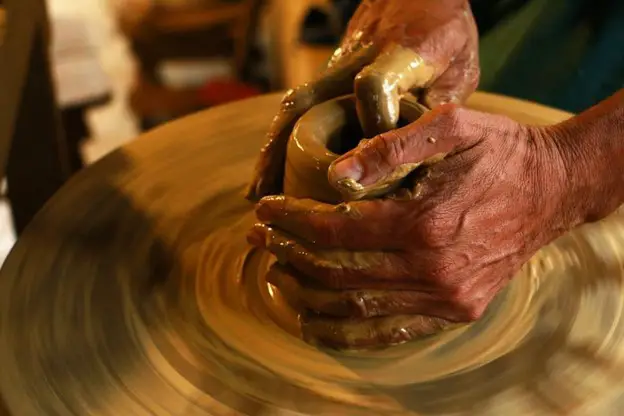
The stiffness of clay plays a pivotal role in pottery throwing. Consider the nuanced relationships outlined below:
- Stiff Clay for Taller Structures: Taller structures benefit from using stiffer clay, enhancing their strength and stability on the wheel.
- Adaptability of Less Rigid Clay: Bowls and smaller structures can effectively utilize less rigid clay, allowing for greater adaptability in the pottery-making process.
- Enhanced Strength through Stiff Clay: Throwing stiff clay improves its strength at the wheel, catering to the unique demands of taller mediums.
The strength of clay in taller creations is of paramount importance for:
- Supporting Additional Weight: A crucial attribute for sustaining the added weight of larger structures.
- Maintaining Structural Integrity: Ensuring stability even when thinly shaped, thus preventing undesired collapse or instability.
Encountering challenges in the seamless throwing of items may be closely linked to the stiffness of the clay itself.
However, it is crucial to acknowledge that stiffness is not without its challenges:
- Manipulative Challenges: Stiffer clay may pose difficulties in manipulation during the pottery-making process.
- Novice Potter Hurdles: Novice potters may find working with stiffer clay awkward and challenging.
- Misjudgment of Water Requirements: Erroneously assuming the need for additional water can lead to unforeseen issues in the crafting process.
Understanding the nuanced dynamics of clay stiffness is paramount. If persistent challenges such as clay falling or difficulty in achieving the desired structural height are observed, a comprehensive evaluation of the current stiffness of the clay is warranted. Additionally, be aware that stiffer clay can add complexity to the centering process, introducing an additional layer of difficulty to the initial steps.
Using Different Clay
Knowing what different clay does is very important. One of the biggest changes and the most important things to know when throwing clay is that different clay generates different results.
Here are some factors that you should consider when choosing a clay body for throwing:
- Porcelain clay tends to hold up better on the wheel
- Stoneware is suitable for medium-sized pieces
- Earthenware is ideal for bowls, smaller vases, and media
- It would help if you understood the plasticity that you’re working with on the clay, too
- The higher the grog, the stronger the clay will be, which means it’ll be stiffer on the wheel
- Clay with more plasticity means it can be workable, and ball clay and porcelain are the best cause they’ve got higher plasticity.
- However, the higher the plasticity, the more likely it is to shrink and warp
- The water absorption rate needs to be low for higher objects
These are some crucial aspects you need to consider with a clay body. Usually, plastic clay is ideal for you to use at the wheel, but it can significantly affect how it handles in your hands and how much time it takes, so you need to ensure this is balanced.
The best way to figure this out is to work with different kinds of clay and understand the best one to work with.
How This Prevents Strain and Makes You Better?
Knowing these two factors will help you with your throwing since it can help with the following aspects:
- The pull, and make sure that you go full with it and not partway
- Your hands will be steadier
- You won’t have to worry about your hands hurting as much
- You’ll have a much stronger point of contact
- You won’t be relying just on your fingers for pulling
Many potters struggle to pull pieces because they use their fingertips or strain when trying to pull the item. It results from an improper clay body or too little water.
If you start to notice that throwing is straining your hand, you should do the following:
- Check the water content of the piece
- Check the plasticity of the clay itself
- Look at the clay body and determine whether or not it’s suitable for throwing
- Look at how much water is left on this and whether or not you have good placement of your hands
- Ensure you’re pulling the clay as much as possible and working with it in a state that’s as malleable as possible.
When you work with clay, you are working with a medium that can be a little hard to get used to initially, but the best thing to do at this point is to figure out the best clay medium to work with.
How to Master This at the Wheel?
The best way to master throwing and get better at it is to do the following:
- Throw pottery more
- Experiment with different throwing media and water content
- Make notes of what you do and change
- If you notice one thing works well, try to adopt that
- Experiment with varying types of clay
When it comes to pottery, the best thing to do is to practice it. After all, if you practice, you’ll be able to become better and understand your clay medium better.
If you notice that your pottery is stagnating and needs a bit of a boost to get better, look at this. It is probably the one thing you could change at the wheel that will help you for the better.
But here is a good wheel to get your pottery going.
Finding the right place to throw pottery can be challenging for many potters, but I tried out the Speedball Portable Artista Tabletop Pottery Wheel and immediately noticed a difference. It is one of the best for practically any throwing surface you work on.
Out of all of the tabletop spaces I’ve tried, this one allows for comfort and flexibility that I didn’t even know you could get with this. It is good for potters who want everything and are still trying to master the best position for throwing.
Click Here to View it on Amazon.
Hopefully, with just this simple change, it will get easier to throw pieces.

